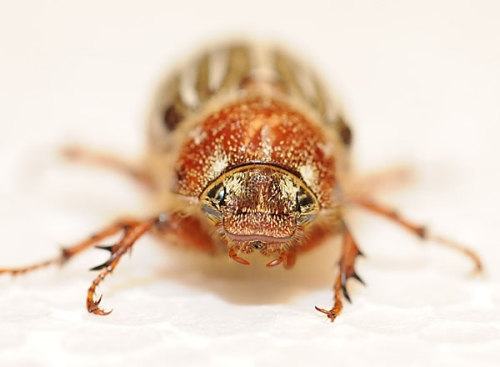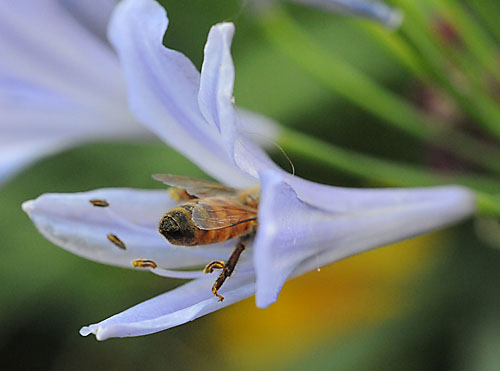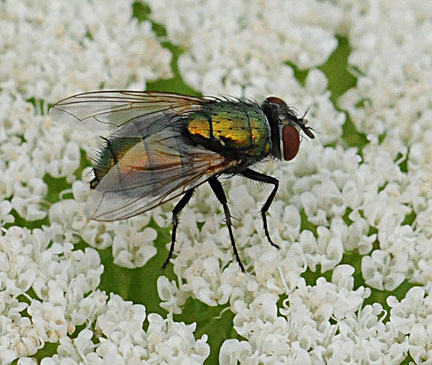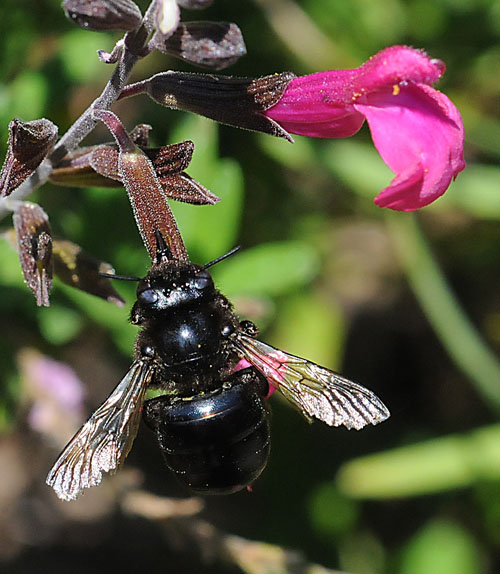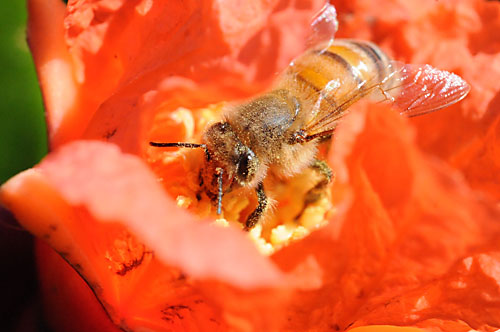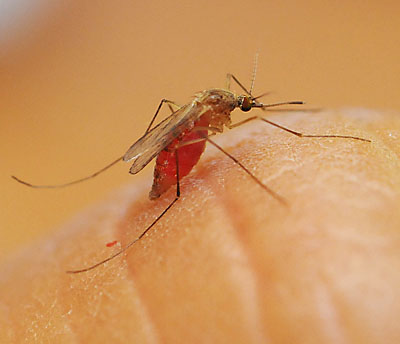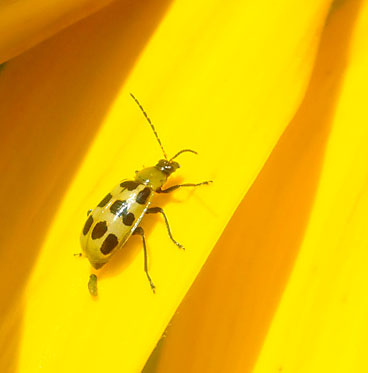- Author: Kathy Keatley Garvey
There's no fame, fortune or glory in writing a daily (volunteer) Bug Squad blog.
It's about the insects. It's always been about the insects, from honey bees to bumble bees, to butterflies, to dragonflies, to praying mantises and more.
Why? Just call it a fascination for insects, which evolved some 400 million years ago. "Three-quarters of all known animals are insects, a staggering 1 million species in total with an estimated 4 to 5 million yet to be discovered," according to a November 2015 article in New Scientist. "By contrast, there are fewer than 70,000 vertebrate species. Harvard University entomologist Edward O. Wilson has suggested there may be as many as 10 quintillion insects alive at any one time – that's 1018, or more than a billion for each person on the planet. They have colonised every continent, including Antarctica. They can live in air, land and water. They even live on us – lice evolved as soon as there was hair and feathers to set up home in. They are the kings of the arthropods – animals…"
I began writing the Bug Squad blog (at the invitation of Pam Kan-Rice) on the UC Agriculture and Natural Resources (UC ANR) website on Aug. 6, 2008, and have written it every night, Monday through Friday, never missing a single night of posting. Today that amounts to 4020. Along the way it's been named the No. 4 "bug blog in the world" (there aren't that many of us!) And, it has won some international awards. My photos have landed on the covers of several scientific journals and popular magazines, and in a few scientific books and children's books (all donations).
My photography has also resulted in thousands of copyright infringements. One man in Austria falsely claimed one of my images and was selling it on four stock photo platforms, including Getty Images. Others deliberately erase the copyrights and steal the images for their commercial purposes.
It's fun until it isn't.
Where do I take the images? Almost all are from our family's pollinator garden. My gear includes a Nikon Z7 mirrorless camera, a Nikon D800, a Nikon D500, a Canon AE1, coupled with half-a-dozen macro lenses. It's exhilarating to capture an image of a honey bee in flight, a monarch butterfly laying an egg, a dragonfly catching prey, or even to go eye-to-eye with a Western yellowjacket.
I don't poke 'em, prod 'em, or pin 'em. I am a guest in their habitat.
So, in 2023, "These are a few of my favorite things" (thanks, Oscar Hammerstein II and Richard Rodgers):
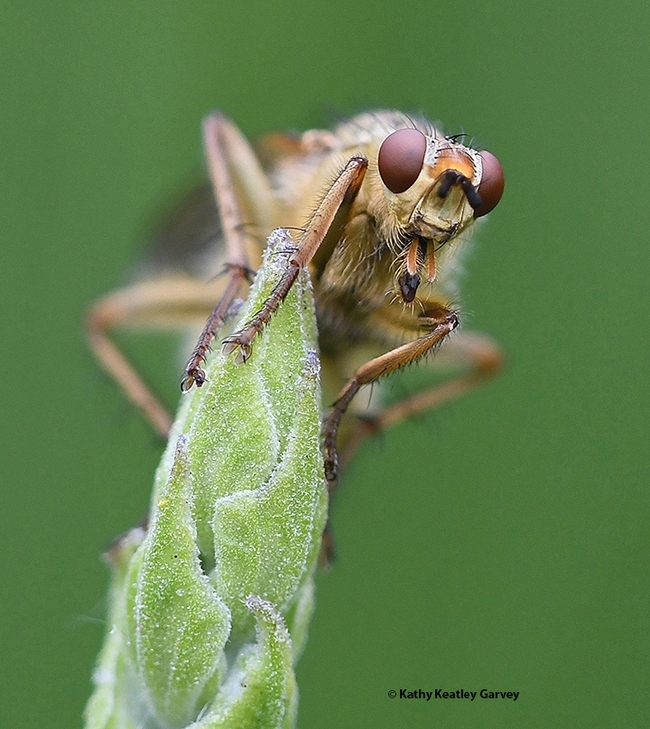
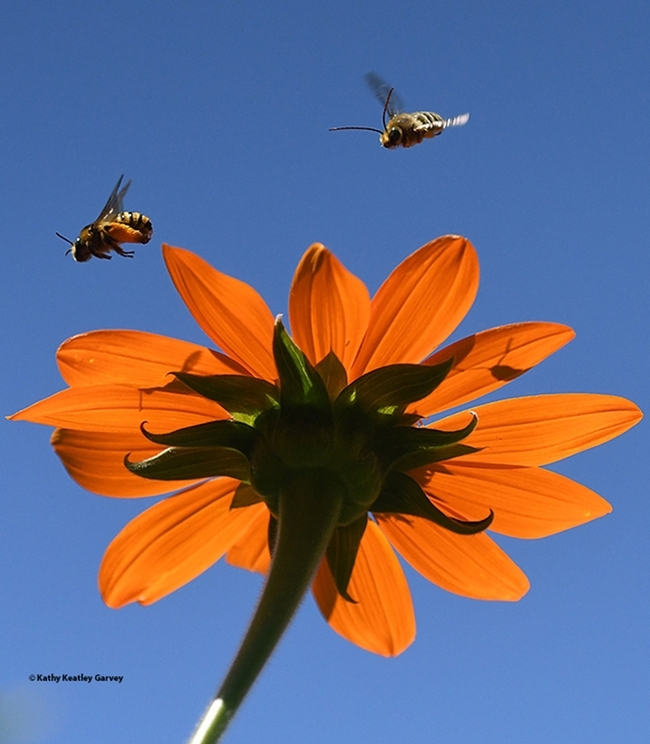
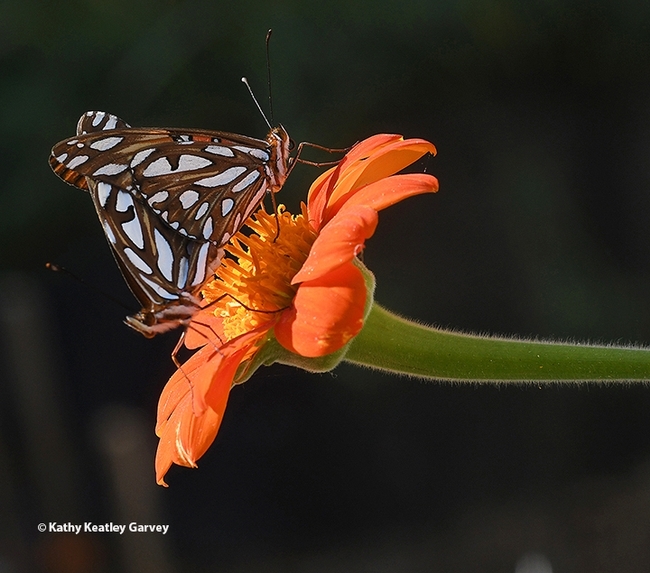
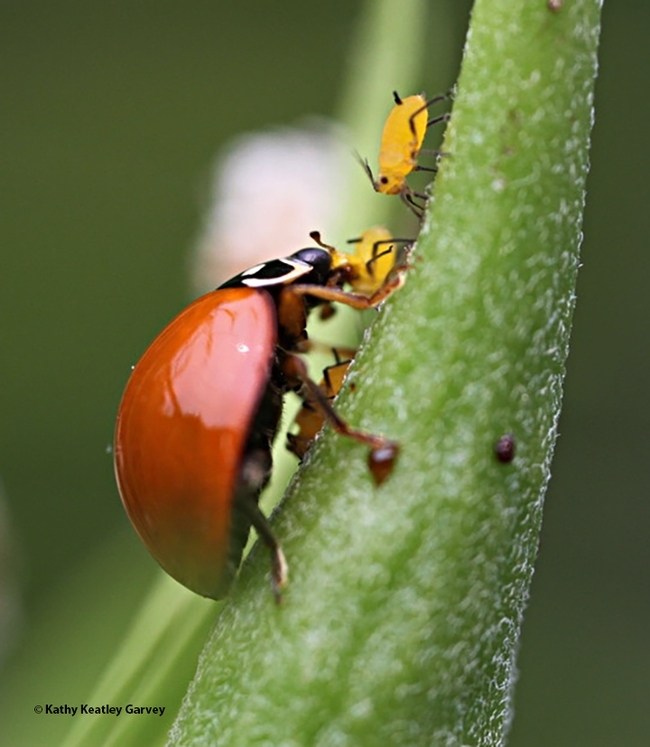
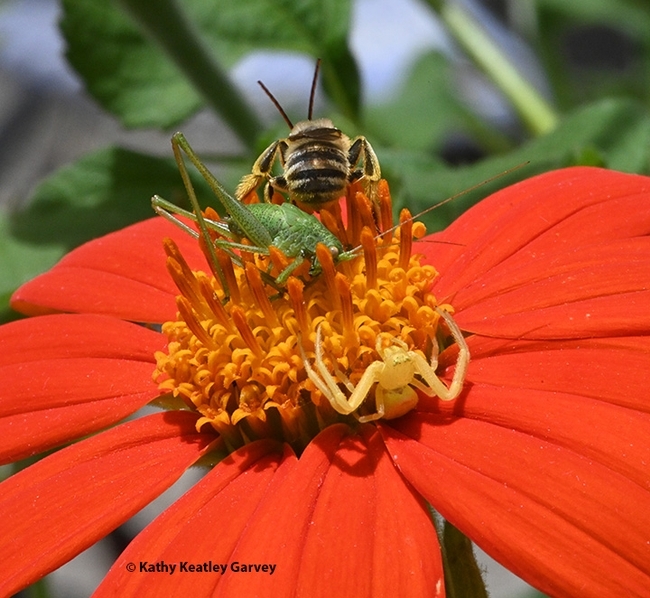
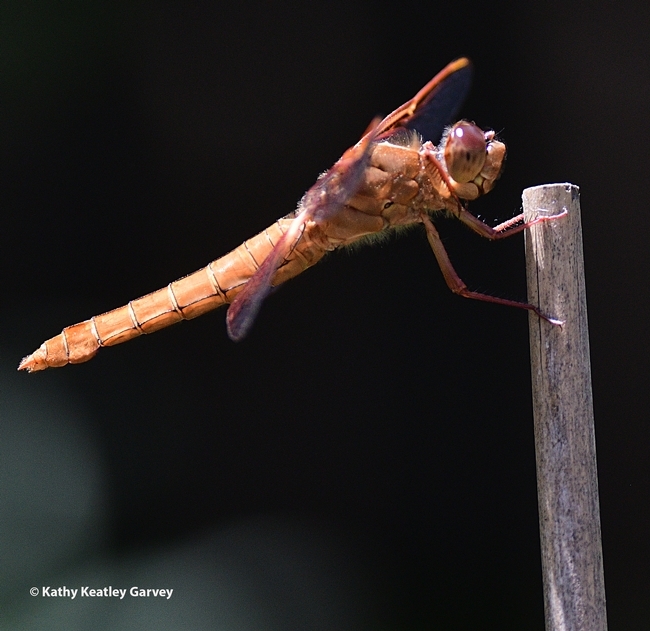
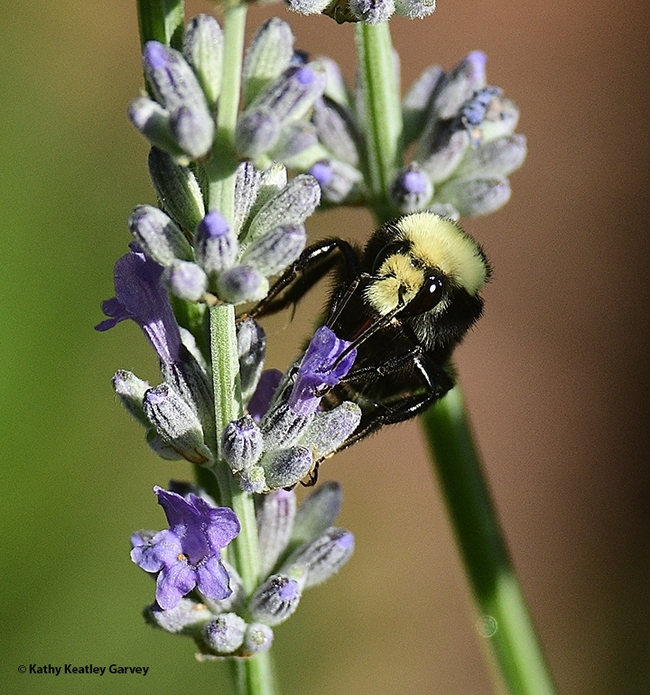
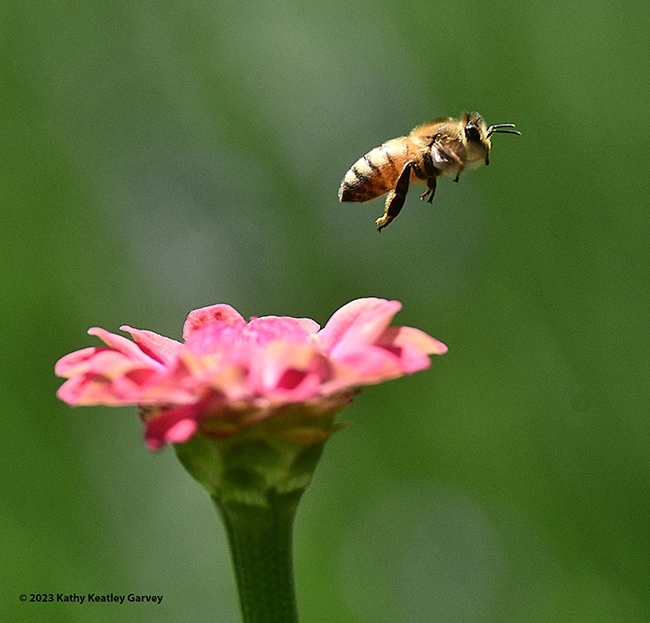
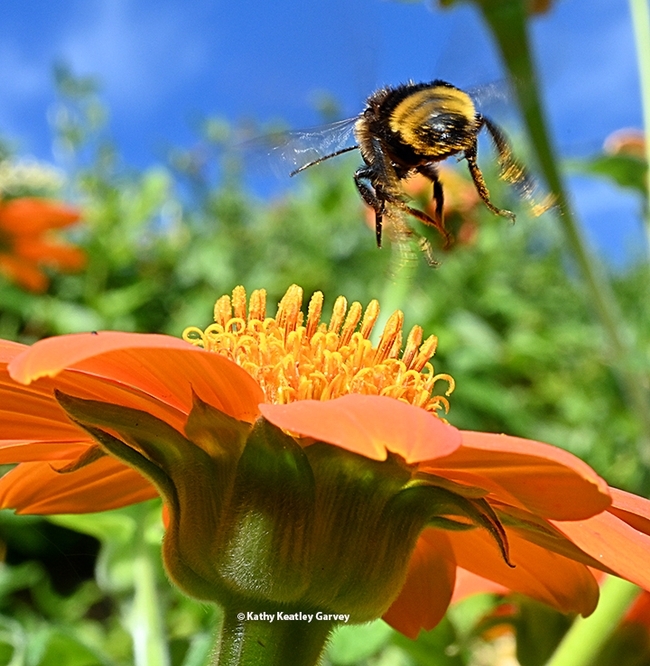
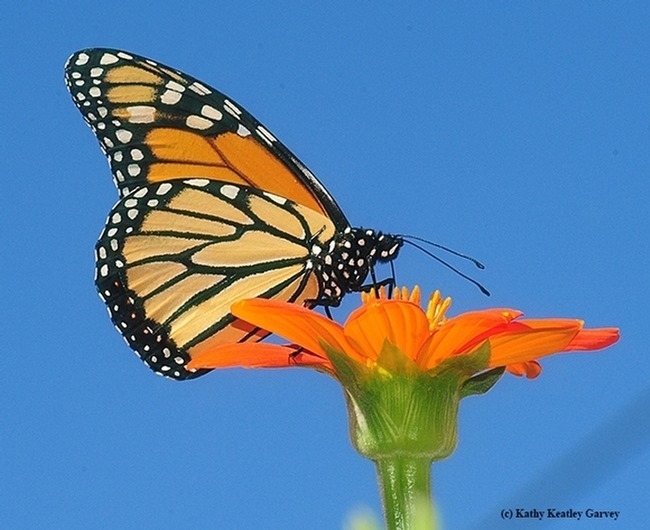
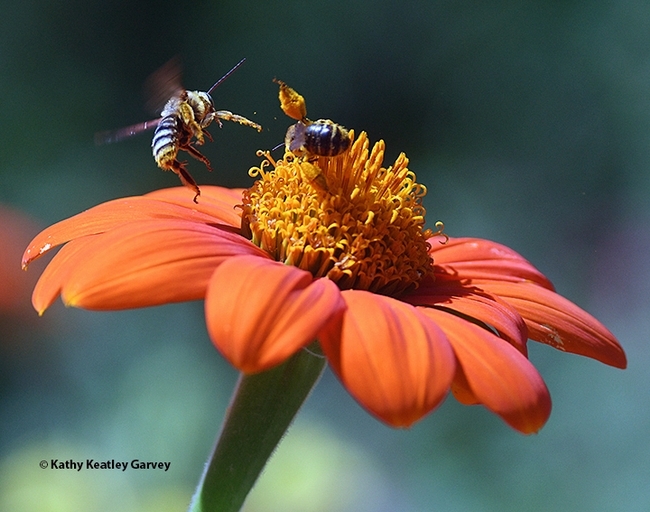
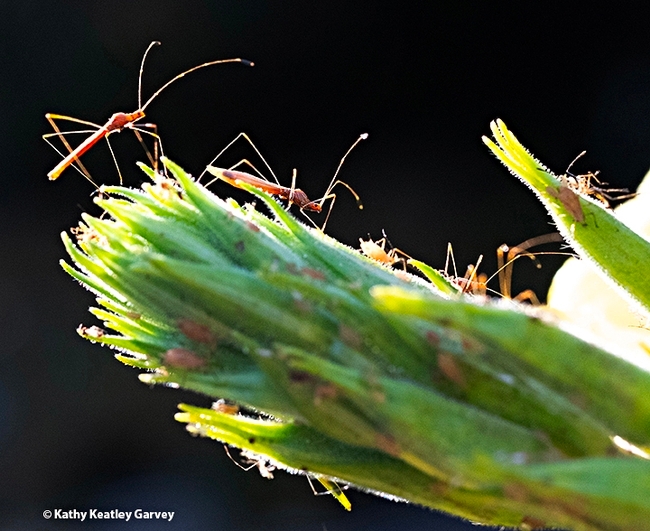
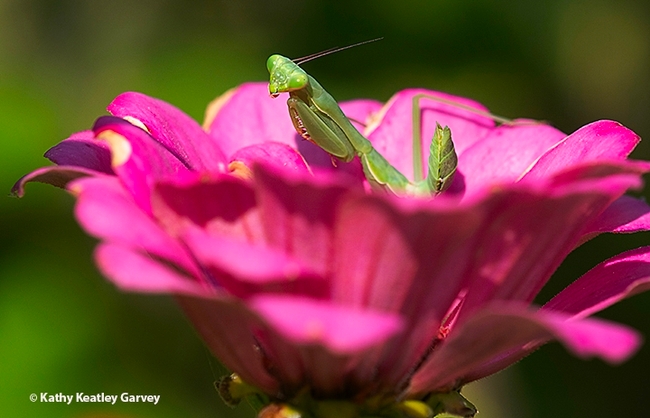
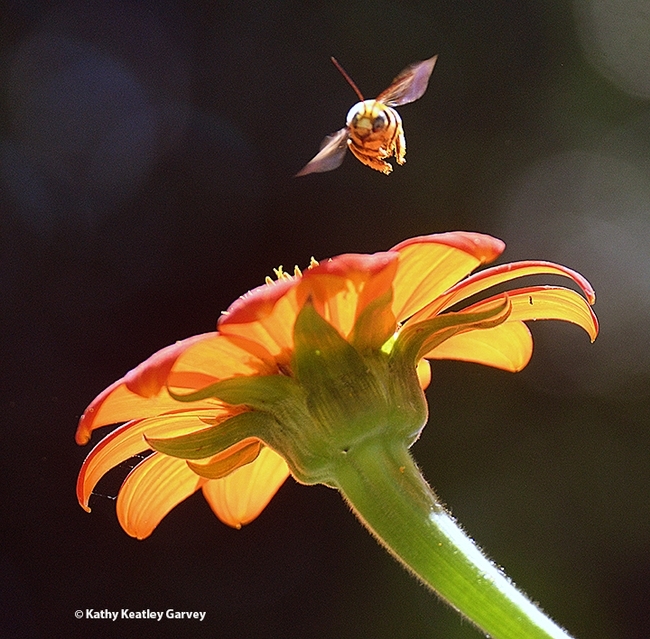
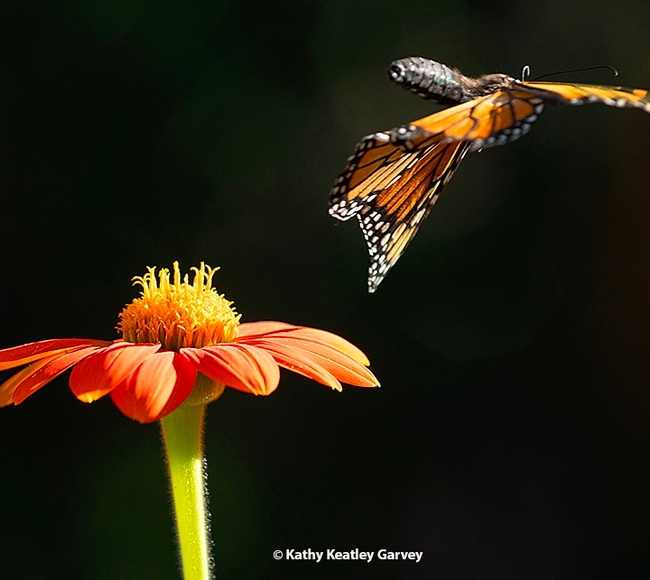
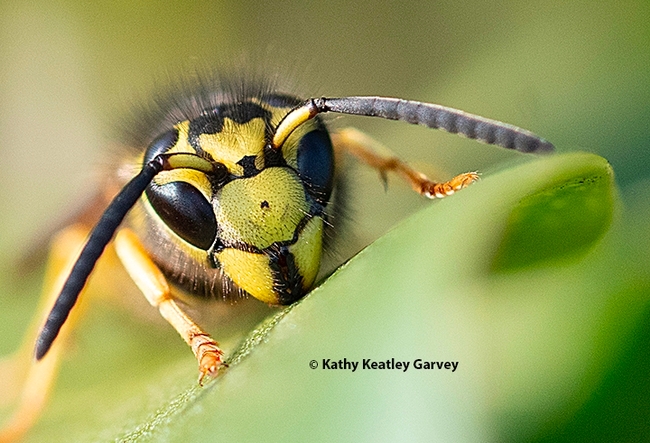
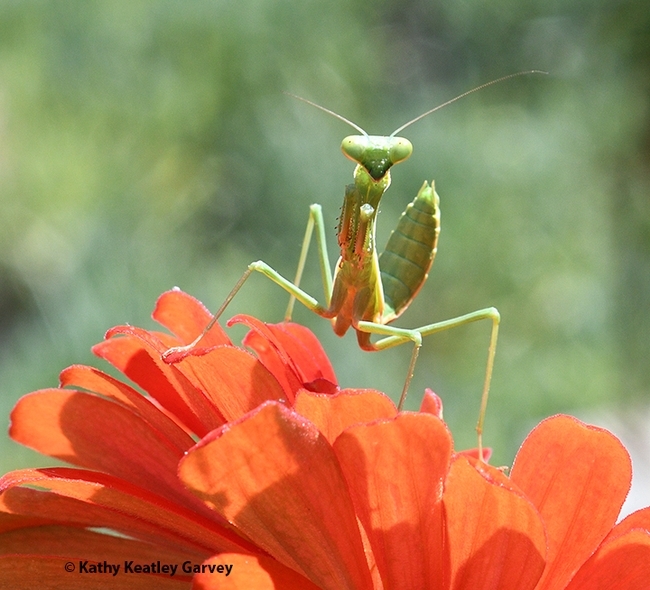
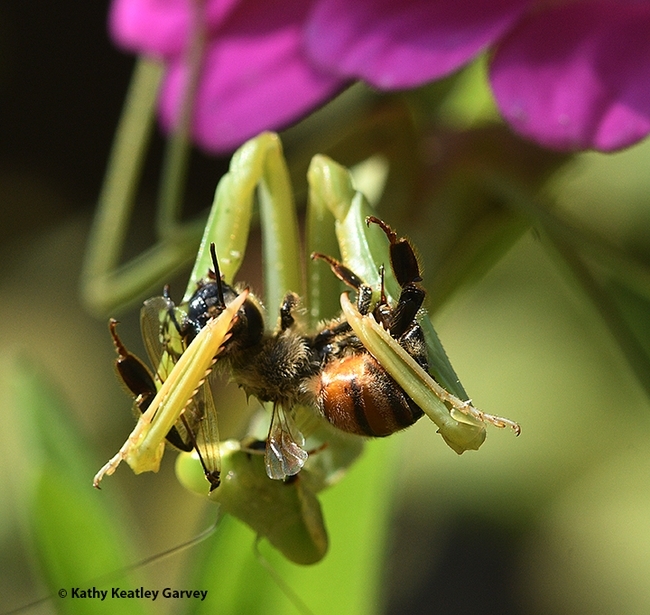
- Author: Kathy Keatley Garvey
To bee or not to bee--a photographer.
Capturing images of honey bees is a delightful leisure activity.
You don't have to sign up for a safari on another continent, or invest in thousands of dollars worth of camera gear.
You can do it all in your backyard (especially if you provide bee friendly plants). Or, you can head for a bee garden or park.
Lately, my objects of interest are the honey bees foraging on our tower of jewels (Echium wildpretii). Earlier this spring, five towers of jewels graced our backyard. Now we're down to one; the others are spent. (They're biennuals and have completed their life cycle.) The sole Echium apparently doesn't know it's time to quit; it has been blooming off and on since April.
Which is wonderful for the bees, beekeepers and photographers!
To get photos of honey bees, I don't poke 'em, prod 'em or pin 'em. I don't spray 'em, glue 'em or freeze 'em. The bees do what they do naturally; I am a visitor in their habitat. I quietly pull up a chair--keeping low to the ground and as obscure as possible--and watch them. No, they won't sting you when they're foraging. They are more likely to show defensive behavior when you're too close to their hive entrance (such as blocking their flight path); when you haven't smoked the hive properly; or when you swat at them.
Lighting is everything. Photography, in Greek, means "writing with light" and that's what you do. Write with light. A little backlighting and a honey bee absolutely glows. Adjust your camera settings and you can stop a bee in flight or capture the redness of its tongue (proboscis).
Early in the morning is the best time to photograph bees. Their flight muscles haven't quite warmed up yet; they move at a slower pace; and they linger longer on the blossoms. One of the bees below clung to the same Echium blossom for two hours before it buzzed off.
These photos were all taken around 7 a.m. the same day on the same plant. The tools: a Nikon D800 camera and a 200 mm macro lens.
Cameras are just that--a tool. They don't make the image; the photographer does. Folks who say "You must have a nice camera" don't understand the creative process or the making of an image. They would never tell a gourmet cook "You must have a nice set of pots and pans" or an artist "you must have some nice brushes" or an athlete "You must have a nice pair of shoes."
That being said, bee photography is something each of us can do, each in our own way.
Read your camera manual. Know the settings. Know what your camera can and cannot do. Learn from other photographers. Look at photos in art galleries, in publications, or on the web. Then head out for a bee safari.
On an African safari, you may not find "big game." But on an insect safari, you will always find "little game."
Always.
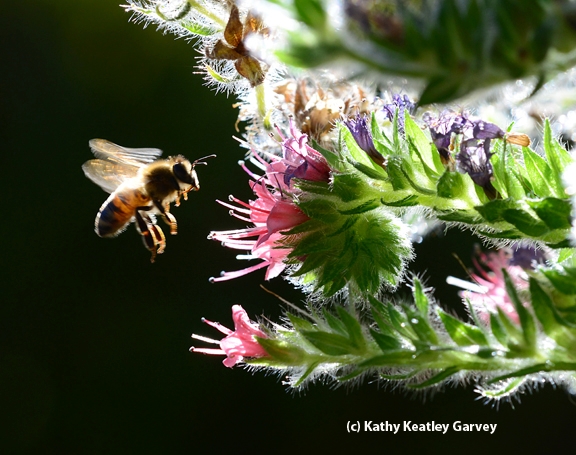
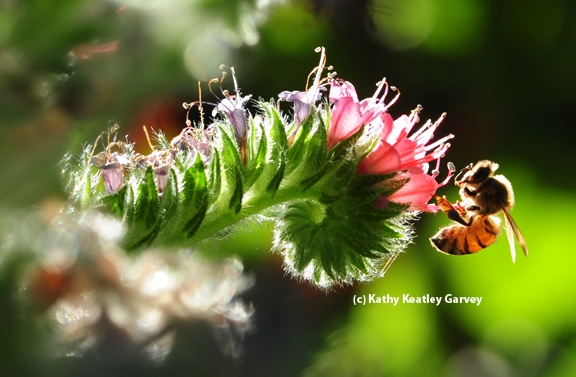
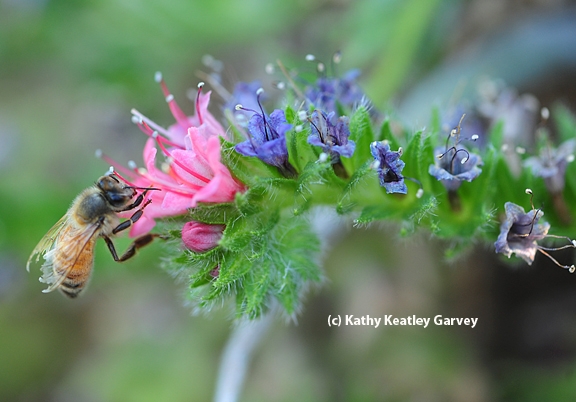
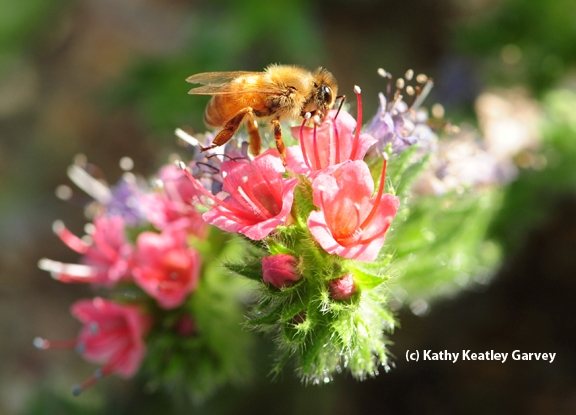
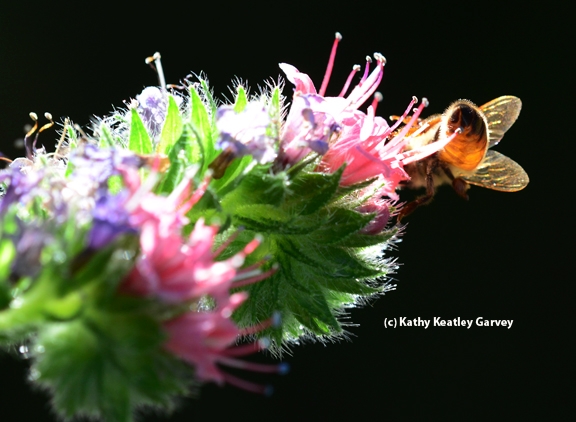
- Author: Kathy Keatley Garvey
Every year the Entomological Society of America (ESA) invites its members and other interested persons to enter the Insect Salon juried photo competition.
It's a highly competitive event, drawing photographs from around the world. The non-profit Peoria (Ill.) Camera Club coordinates it.
The macro images are amazing. You'll see, on the Insect Salon Web site, insects in the act of being themselves: feeding, flying, crawling, taking off, resting, hanging around, mating--and yes, even a honey bee cleaning her tongue. (That would be one I took of a cooperative bee in Tomales, Calif.)
The winning images include bumble bees, carpenter bees, damsel flies, dragonflies, katydids, grasshoppers, monarchs, moths, scorpion flies, skippers, swallowtails, robber flies, and assorted beetles.
ESA members viewed the winning images on screen at their recent meeting in Indianapolis.
Bigger than life!
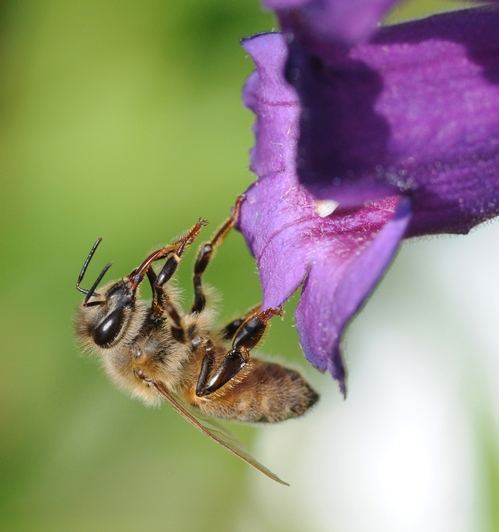
- Author: Kathy Keatley Garvey
If you spot a ladybug, don't just start reciting "Ladybug, ladybug, fly away home."
Aim, click and shoot.
With a camera, that is.
Agricultural Research Service scientists and entomologists at Cornell University, Ithaca, N.Y., and South Dakota State University, Brookings, are surveying the country's ladybug species.
They want you to photograph every ladybug you see and send the photos to them so they can inventory them. They are specificially seeking rare species, such as the nine-spotted, two-spotted and transverse ladybeetles, but any and all ladybugs will do.
Ladybugs, also known as ladybeetles (familyCoccinellidae and beetle order Coleoptera) are the "good guys" and "good gals." They prey on insects that eat our agricultural crops. They also help protect our nation's forests.
The scientific project is titled "The Lost Ladybug Project." Everything you've always wanted to know about ladybugs is at "Legends, lore, facts and more."
The good folks at The Lost Ladybug Project also offer some photo hints. They know that the bugs may not sit still for a photo shoot (let alone "smile") so they recommend you pop them in the freezer to slow them down. "You can do this in a freezer at home or in a cooler in the field," they say on their Web site. "Lady beetles can be chilled in a freezer safely for 5 minutes (over six may kill them) and this will quiet them for 2-4 minutes. Coolers are not as cold as freezers so it will take 30+ minutes to get 1-6 minutes of quiet time. They will survive for days in a chilled cooler."
Nope, I did not "chill" my ladybugs. No ladybugs were harmed or "chilled" in the making of these photographs. I popped the 60mm macro lens on my Nikon and stealthily waited amongst the Russian sage.
Gotcha!
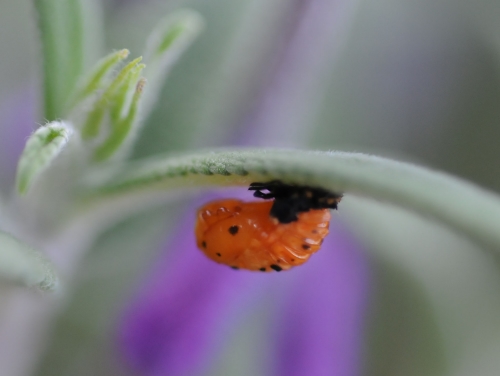
- Author: Kathy Keatley Garvey
I've always loved the wit and wisdom of insect-inspired poets.
God in His wisdom made the fly
And then forgot to tell us why.
- - Ogden Nash "The Fly"
We hope that, when the insects take over the world, they will remember with gratitude how we took them along on all our picnics.
- - Richard Vaughan
If you look at the world through a viewfinder--as I have a habit of doing--it's a wonderful, exquisite place, especially if you capture critters in their natural habitat. They don't complain when you make them look fat, skinny, nice or ferocious.
Blow flies, honey bees, carpenter bees, spotted cucumber bees, the ten-lined June beetle, and mosquitoes all appear in my viewfinder. Okay, I know. We're not supposed to like some of these pests (such as the carpenter bees, spotted cucumber bees and the ten-lined June beetles), but hey, all of them are pretty enough to sing the national anthem at the Olympics.
Photography, or writing with light, is just that. Writing with light. Back before the digital technology age, we used to process film, make prints and then hang them out to dry. We "pho-togs" marinated ourselves in Dektol, DK-60 and Hypo.
Our "pheromone" wasn't always appreciated. But the images were.
Bees are black, with gilt surcingles,
Buccaneers of buzz.
- - Emily Dickinson
The mosquito is the state bird of New Jersey.
- - Andy Warhol
